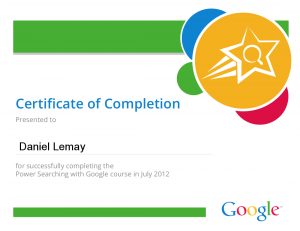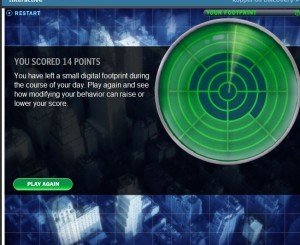Main Area
Student Voices
Posted on August 6th, 2012
Whether people are telling a story, promoting a cause, grousing about something or sharing something they value with the world, giving people a voice via the Internet is truly one of the best things about the World Wide Web.
I know the assignment for Week 5 #digitfoot12 seemed geared to current active student voices. The voice that I could only think of when assigned to share a student who’s social networking affected me was one I followed for a short period of time two years ago.
During 2010, I found out about Abby Sunderland and her dream to be the youngest person to solo around the world sailing. She did not make it, but the story was fascinating.
She (or her parents) set up a web site documenting her progress and you can read her story starting here. I was enjoyed reading about her hopes, dreams and the travail she endured preparing for this trip and as she departed. The telling of her story was what I found so fascinating. It is so different from how I’ve lived my life that I was intrigued by this young woman’s drive. Her supportive family allowed her to attempt to reach for this goal. Isn’t that what allows most young people to achieve!
Searching, Sharing and Building a PLN
Posted on July 28th, 2012
I finished the Google Power Searching course just about the time Digifoot12 Week 4 began with the focus being searching and vetting the value of web sites. I’ve also been searching on Twitter to see what is of value on that network. I came across the hashtag #made4math. It appears to be a way for people to share cool things they’ve made for their classrooms or for conducting math classes. Some are sharing cool activities.
This got me thinking, remembering one of the best PD days I’ve spent in the 24 years I’ve been teaching. Vermont ASCD ran a workshop with Nanci Smith, a math teacher from Arizona. Her shtick was differentiated instruction/assessment. I walked away with more good ideas from that day than any training before or since.
To connect these two ideas I have running through my head this week, I decided to make a “cool activity” to share on #made4math Monday this next week.
One activity I learned about was to take a plain old boring worksheet and create a crazy puzzle for students to work cooperatively and solve. I drew a set of 16 2” squares arraigned in a 4 by 4 grid PDF . I used Kutasoft to generate a bunch of problems with the corresponding answers on simplifying exponential expressions. I cut them out and arraigned them on the grid PDF.
I run about 6-12 copies depending on how many groups I want. On each copy I’ll write a letter on the middle of each square. The way I get the letters is to open any book and grab the first letter in each paragraph, just make sure for your sake that each square has a different letter.
Make a copy of each before you do anything else. This is your answer key. If you are going to do this in multiple sections, remember to make copies for the other sections
I use the same puzzle, just have different letters on each copy. They kids think they have different puzzles which gets them working and not just copying the next group/table.
Then carefully cut out the squares. A paper cutter works best. Place each set of 16 in an envelope.
Hand them out to students. Tell them to match up the exercise with the answers and when they are done they will have a 4 by 4 square. Notice I added distractors around the outside.
Some students don’t want to participate. I give them the plan odd hand out. I’d share that here but I’m not sure of Kutasoft’s rules on sharing the handouts made with their software. They do have free ones available at their web site.
Using the Kutasoft and cut and paste is a new direction. I typically write these out by hand. Here is one I made last year for a group of students that needed review with percentages. PDF Is using Kutasoft better? I don’t know, it took a lot longer to create.
I hope I’ve explained this well enough. Give a yell if you don’t understand something.
Google Power Search Course
Posted on July 24th, 2012
I just received the certificate from the Google Power Search course I completed this last week.:
A Community of Learners
Posted on July 19th, 2012
AKA= Being a digital citizen in my world.
I’ve spent most of this evening helping my online students, helping a fellow Calculus 2 classmate with finding centers of mass, integrating by parts and substitution. Someone please remind me why in the gods names I thought taking Calc 2 as a refresher course this summer was a good idea? Then I’m trying to reteach myself integrating using trigonometric substitution.
Back to digital citizenship. Participating in the digifoot12 MOOC this summer has spurred me into thinking about where teaching and learning are going? I know the majority of HS students in my State would not be too successful being thrown into a MOOC without a lot of support on the ground (an ox goad?) . Hopefully as a course progressed, they would become self sustaining learners, and be able to dig the understanding out for themselves. That is what we want: life-long learners.
How do you get help when you’re out in the aether by yourself? Youtube videos, Purplemath and Paul’s Calculus notes are all good resources but more importantly, learning to interact cooperatively with people at the other ends of these wires is the best skill to acquire. Knowing how to ask for help in an appropriate manner is a good skill to learn. It is really easy to blame someone else for your failures, but in online learning, the drive, time and commitment MUST come from the student. When all students are coming together with this kind of drive, then the online classroom is a beautiful place to be!
One thing to note about my own learning this evening: It is nice to see that how I teach students to find derivatives of inverse trig functions applies directly to the technique of integrating using trigonometric substitution. Thanks Stu Swartz! <link>
Connecting with others
Posted on July 17th, 2012
I’ve spent a week using Twitter as part of the digifoot12 MOOC I’m participating in. I can see how teachers can find twitter a useful tool as part of their PD. One gem I’ve walked away from this last is coming across Keith Devlin’s Mathematical Thinking MOOC he is planning for the fall. I’ve already emailed my Principal, Guidance Director and Department Chair about how I’m thinking of having my precalculus course participate in it, provided the content is appropriate for them.
Where do I need to go now to leverage Twitter into a tool that I use in a regular basis as part of my professional growth? I need to research what hash tags my fellow math teachers are posting to. I’ve found plenty of teachers and some discussions about mathematics but nothing so far (aside from Keith Devlin) that is intriguing.
One Twitter tool that proven to be useful is tweet deck. I like the interface and the way it can be customized.
I’ll keep looking and researching connections for the rest of the summer. I’ll see what comes of it.
FootPrint Wordle
Posted on July 9th, 2012
Home | Scribophile, the online writing group for serious writers
Posted on July 8th, 2012
Social networking for writers.
Home | Scribophile, the online writing group for serious writers.
One of the best writing experiences I’ve ever had was taking a writers workshop at SMC <link> prior to starting my MEd. A group of about 10 people who did not really want to be there on Saturday mornings. We had an assignment each week to write and revise and more importantly provide feedback on other peoples’ work. This Scribophile site seems to be in a similar vein.
This morning I’ve read a couple of pieces of work and looked at the critiques others have left. This is something I might make the time to participate in.
Discovery Channel Footprint Quiz
Posted on July 8th, 2012
I followed a <link> left by a classmate out at Mightybell to this “quiz” . Here is how I scored:
A couple of comments: A number of questions really were more applicable to people living in an urban setting. For example, CC cameras are not present in a rural setting. I can walk through downtown Bradford without any recording of me doing so. So my “low score” is partly due to the environment I’m living in.
This brings to mind the issue of cell phone access and broadband Internet access in a rural setting. My family still has a land line and we only have a couple of prepaid cell phones for use when we are traveling. I can’t get a cell phone signal in my house and even outside I need to walk about 100 feet down the driveway to cell a couple of bars. These limitations will affect, to some extent, how I’m tracked and how much data is collected on my activities.
As far as Internet access, while we have a DSL line, it is an ADSL line and the upload speeds are not much better than a fast dial-up line. Uploading a 36 meg video to youtube required 2 hours of time earlier this week. I need to plan ahead and get the video on my school laptop and use the schools cable connection to upload and this has to be before school starts if I want it to work.
I still have students who do not have a computer never mind broadband access. For some it is a cost issue. For others, cable/dsl connections still are not available. Satellite Internet is too expensive and limiting so I don’t see this as an option for most people. It is difficult to assign Internet intensive assignments when I have to accommodate the don’t haves.
We are still a bit distant from an always connected society. There are still a lot of holes in data collection by “Big Brother”.
Dan Lemay lemaydan on about.me
Posted on July 6th, 2012
I’ve started building an about.me page.
Dan Lemay lemaydan on about.me.
Listening to Jeffrey Bradbury’s Podcast 21 has me really thinking deeply about what I want on this page.



